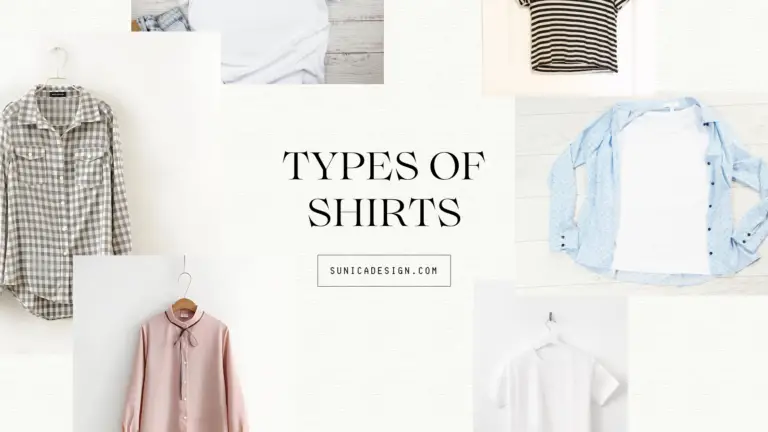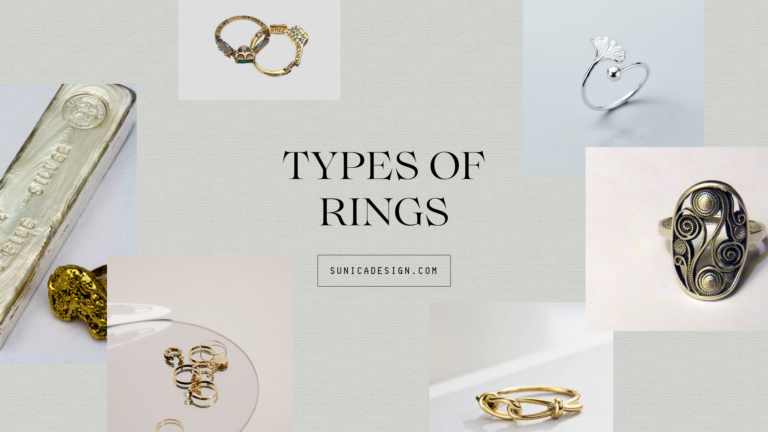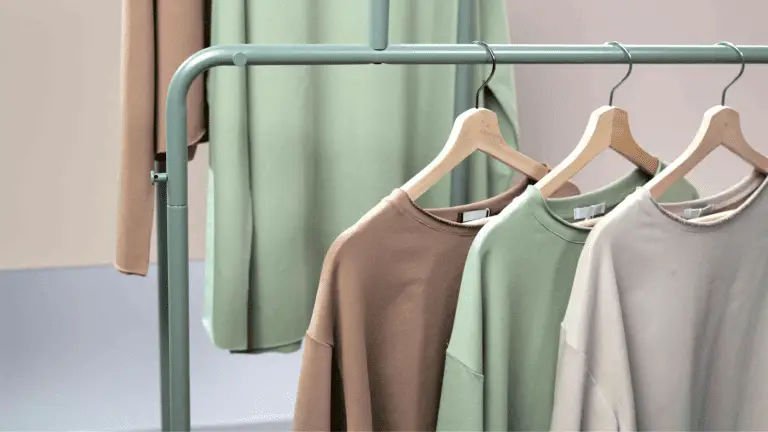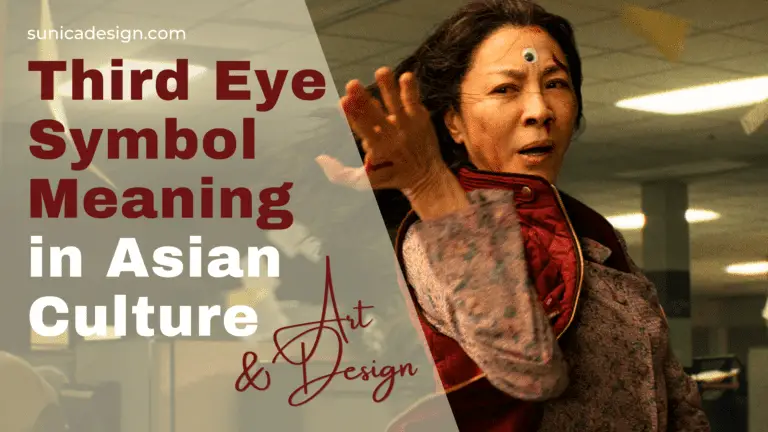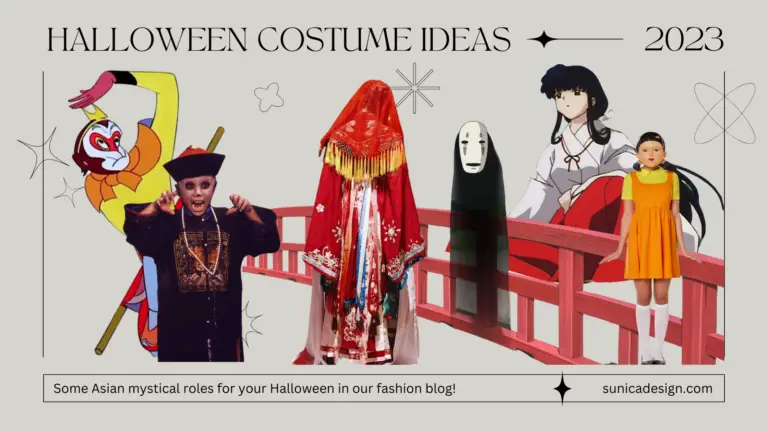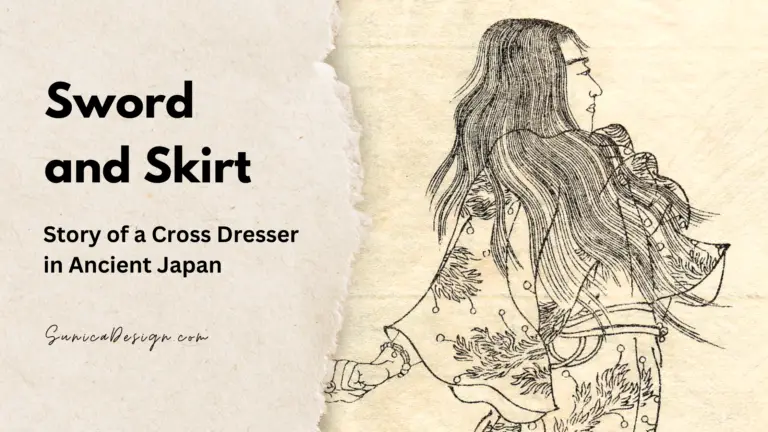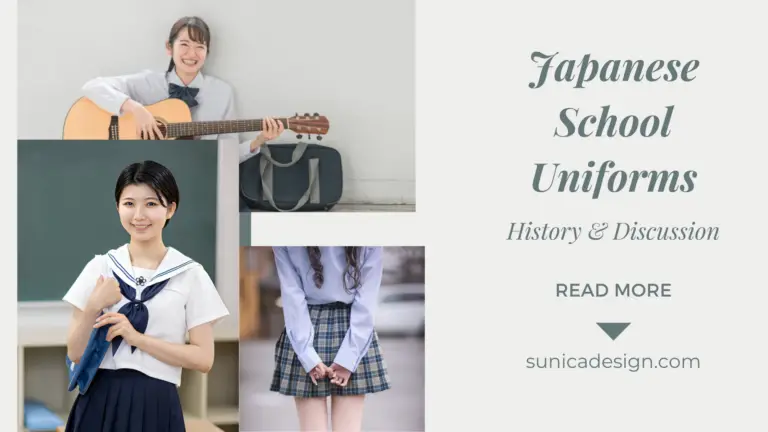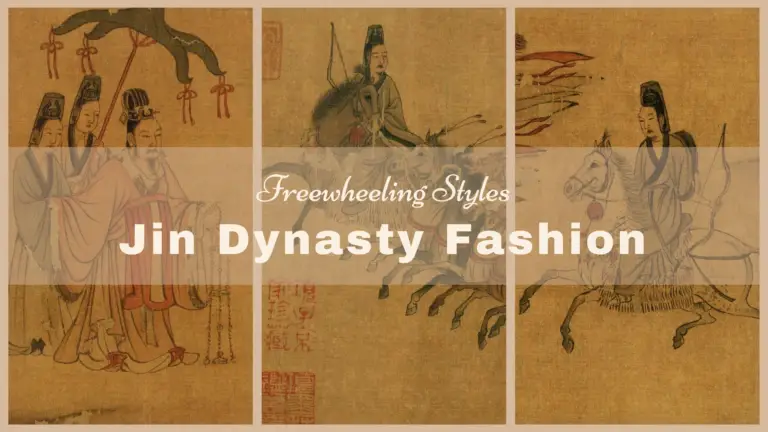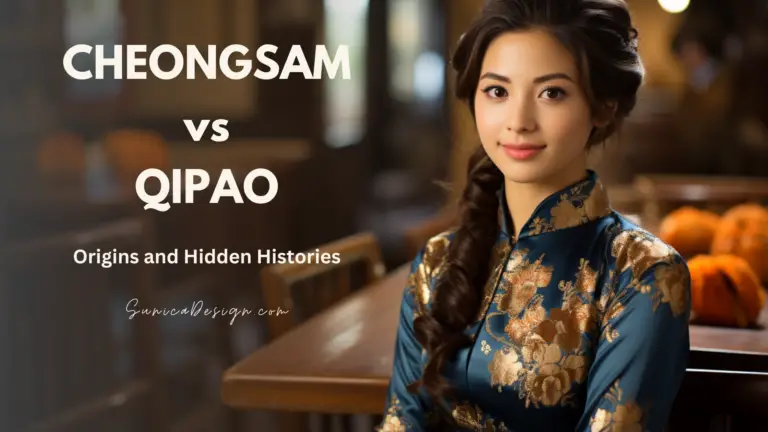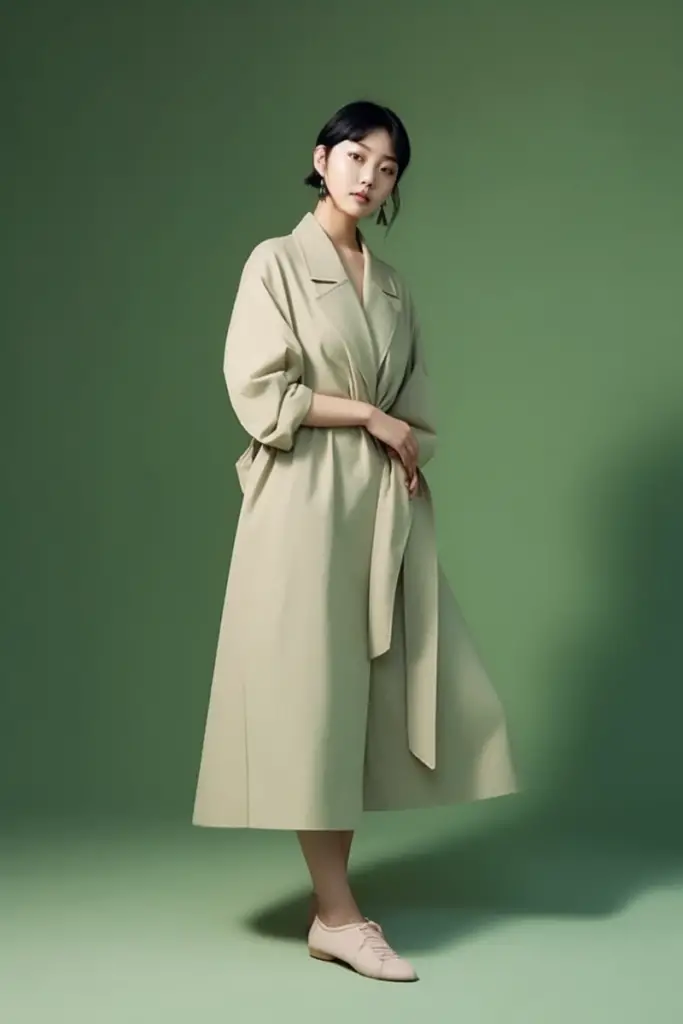Recently, we published an article about Yukata vs. Kimono, and then we thought: why not just make an article about all the types of kimono and detailedly introduce them all? In our previous discussion, we only scratched the surface. So now we wish to take you on a journey through all the types of kimonos, discovering their unique beauty and purposes. Join us as we unfold the intricate details and embrace a part of Japan’s rich cultural tapestry!
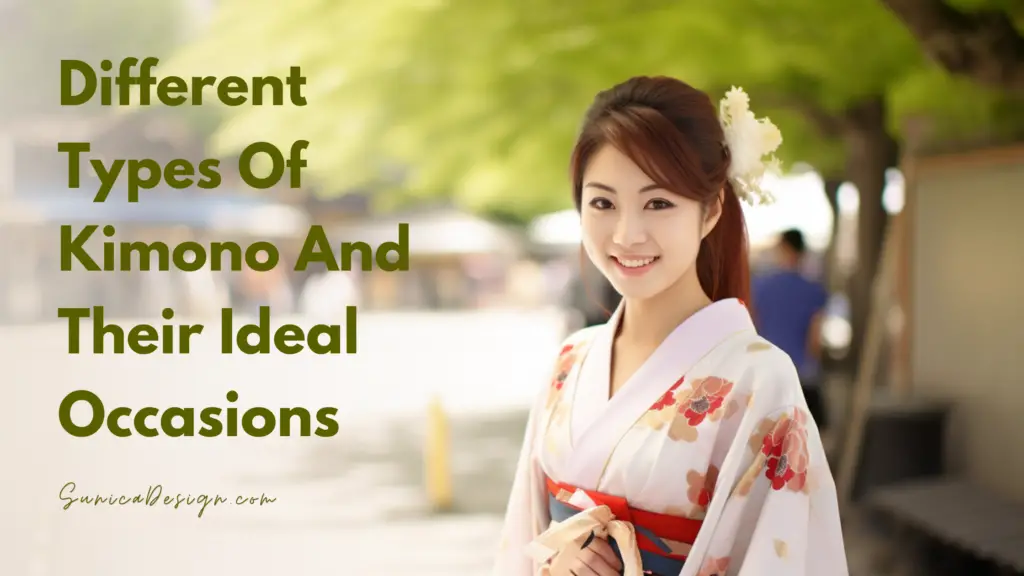
Formal Types of Kimono
Shiromuku 白無垢 (しろむく)
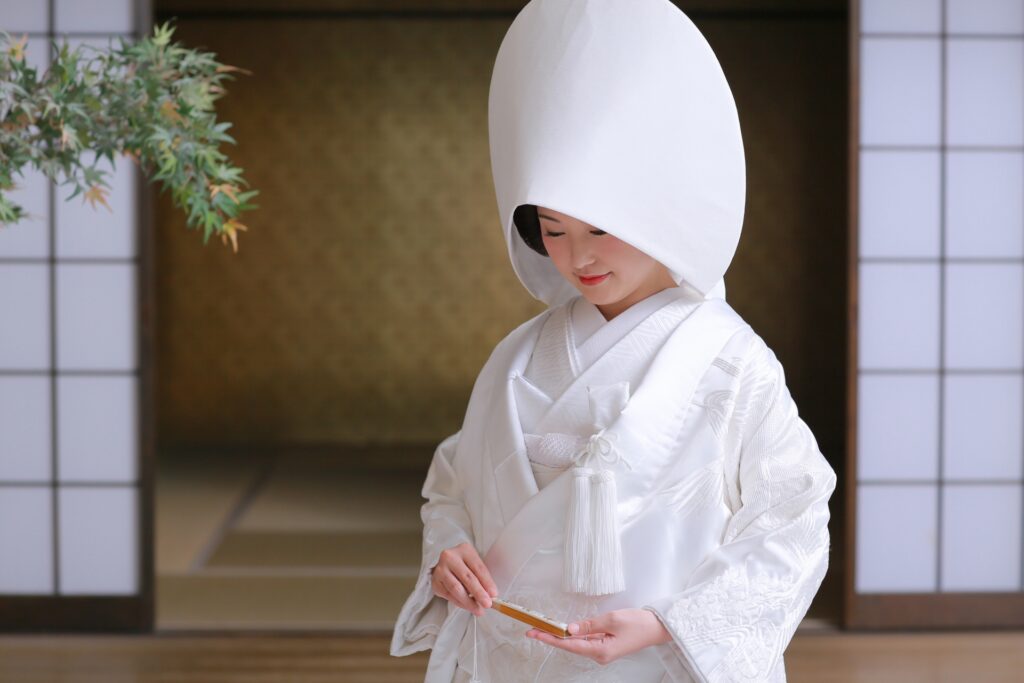
The Shiromuku, 白無垢 or しろむく, holds a revered place in Japanese Shinto wedding ceremonies. This pure-white kimono symbolizes innocence and purity and is often worn during the initial part of the ceremony. Later on in the ceremony, it might be switched to a red uchikake, which conveys good luck and the start of a new journey.
There are many accessories to accompany the Shiromuku. A bridal wig known as ‘katsura,’ elegant kanzashi hairpins, usually crafted to mimic tortoiseshell, and a sensu fan tucked into the kimono make up the ensemble. These elements not only enhance the appearance but also imbue the outfit with deeper cultural resonances.
However, owning a Shiromuku isn’t common in Japanese families, given its expensive nature and specific use. It’s like owning a top-notch tuxedo you only wear once. Many brides choose to rent them. Even Shinto shrines get in on the act, keeping and renting out these symbolic garments for traditional weddings.
Inherited Shiromuku are usually treasured family heirlooms passed down through generations. If you see a bride wearing an inherited Shiromuku instead of a rented one, she is showing her family bonds and highlighting the enduring nature of this kimono’s cultural values.
Uchikake 打掛 (うちかけ)
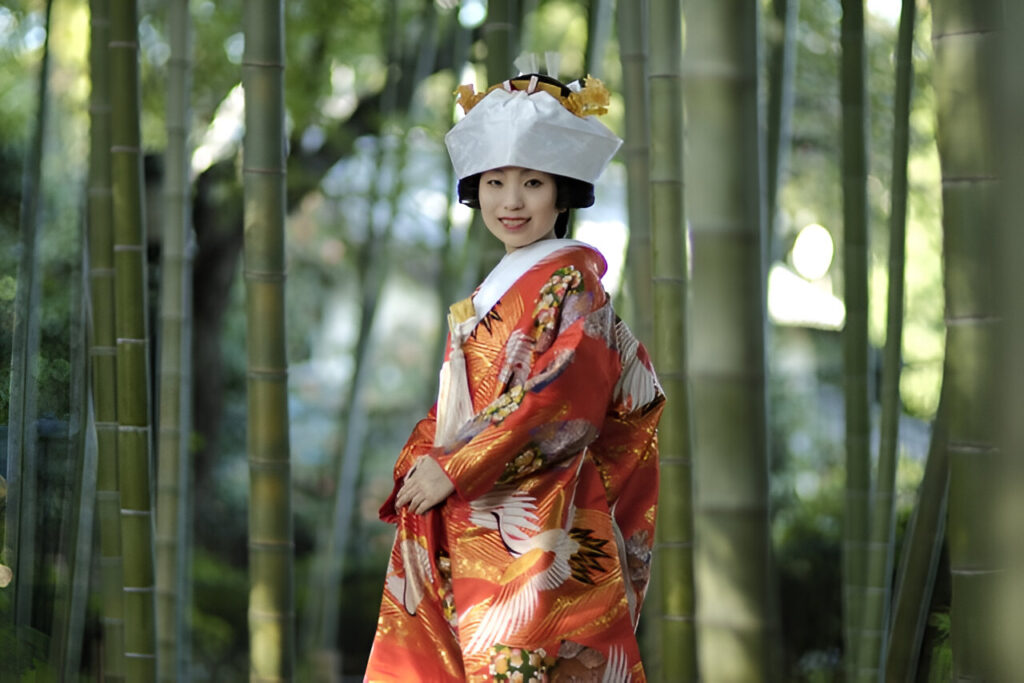
Shiromuku is very similar to a kind of kimono called Uchikake. Actually, some people will just call Shiromuku a white Uchikake. So what is Uchikake look like? Well, unlike regular kimonos, Uchikake is an unbelted outwear designed with heavy decoration. During the Edo period, brides from upper-class samurai families adorned themselves with Uchikake bearing silver foils or embroidered with silver. Daimyo (Japanese great lord)’s daughters would layer several Kosodes, add bright red hakama, and top it off with Uchikake. Without the need for an obi (a traditional Japanese wide belt), Uchikake’s motifs can cover the entirety of the back, allowing for unbroken and more intricate patterns.
After World War II, rental services of Uchikake became mainstream, with the white and red Uchikake for religious ceremonies and the colorful ones for receptions.
Mofuku 喪服 (もふく)
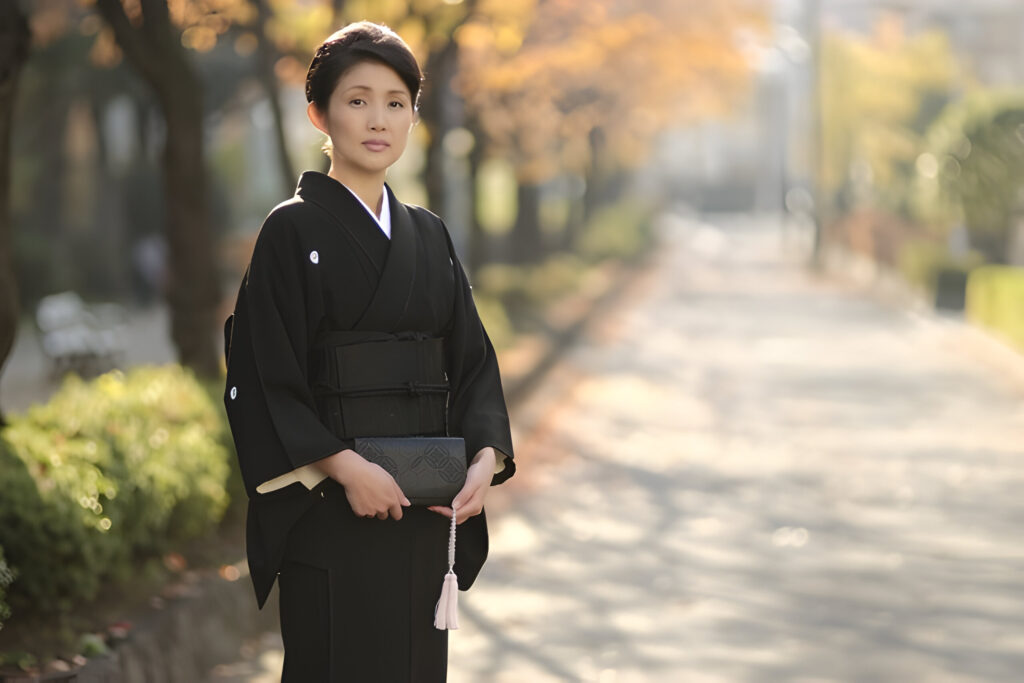
Mofuku, or Japanese mourning kimono, signifies respect and grief during funerary customs. Traditionally featuring five family crests and solid black, this type of kimono has strict rules on patterns and colors.
There’s also a variation called ‘Ryakumofuku.’ This attire pairs subdued colors like grey or brown with a black belt, often donned by distant relatives of this family or during annual memorial ceremonies.
Originally white, Mofuku became predominantly black during the Meiji era, influenced by Western mourning customs. Both unmarried and married individuals wear this attire to show their cultural respect for the deceased.
Furisode 振袖(ふりそで)
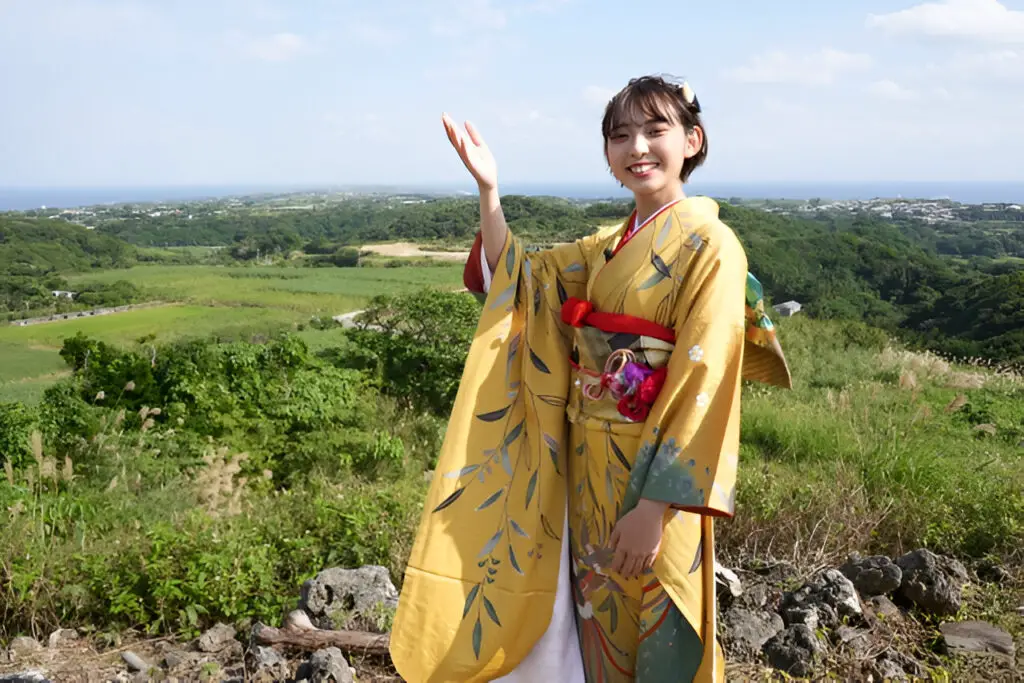
Furisode, a traditional Japanese kimono with distinctive long swinging sleeves, is a symbol of grace and elegance. It’s a go-to garment for young women at significant events like coming-of-age ceremonies and weddings.
According to different sleeves’ lengths, there are mainly three types of Furisode kimono: Small Furisode with 85cm or shorter sleeves, Ordinary Furisode with medium sleeves, and Large Furisode with 114cm or longer sleeves. The small Furisode is mainly for graduations; the ordinary Furisode is for coming-of-age ceremonies or weddings; and the large Furisode is for brides at weddings.
Ever heard of a dress becoming a different one post-wedding? Well, you can see the Furisode’s sleeves shortened in a traditional Japanese wedding, transforming into a Tomesode, which symbolizes a transition from a young unmarried woman to a wife.
Black Tomesode 黒留袖(くろとめそで)
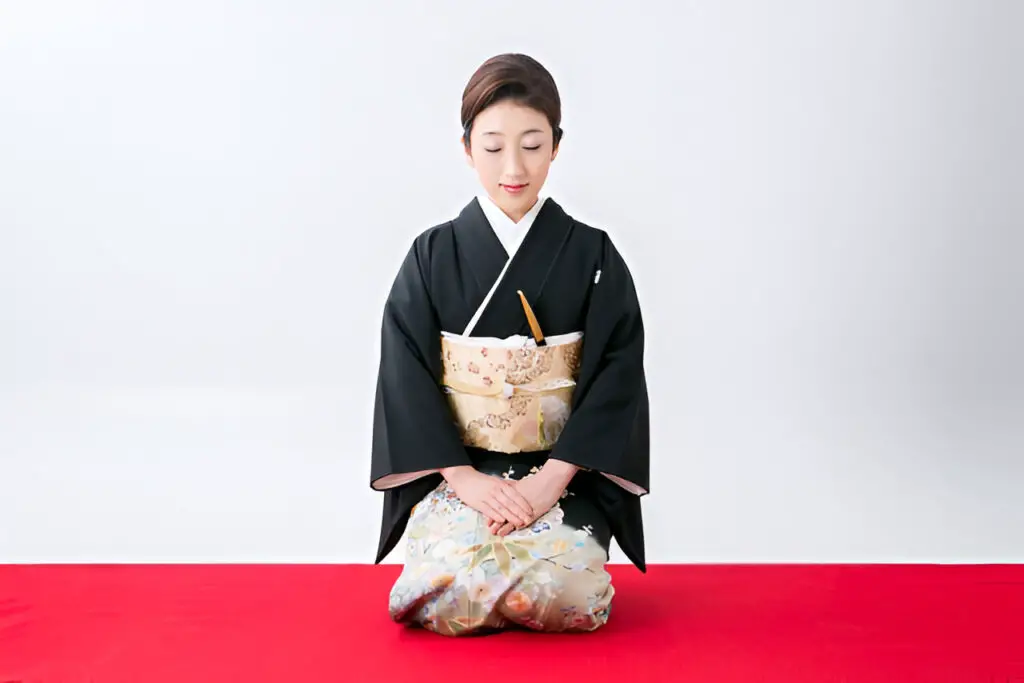
The Black Tomesode is a pinnacle of elegance in the kimono world, a formal attire exclusively reserved for married women.
At events like weddings, the black Tomesode is worn by the groom and bride’s mothers, close relatives, or matchmakers. Adorned with five family crests, this kimono shows family bonds and gives off an air of elegance.
This clothing is often made from silk with a snazzy ‘絵羽模様’ (ebamoyou) pattern on the bottom hem, leaving the upper half plain.
Semi-Formal Types of Kimono
Iro Tomesode 色留袖(いろとめそで)
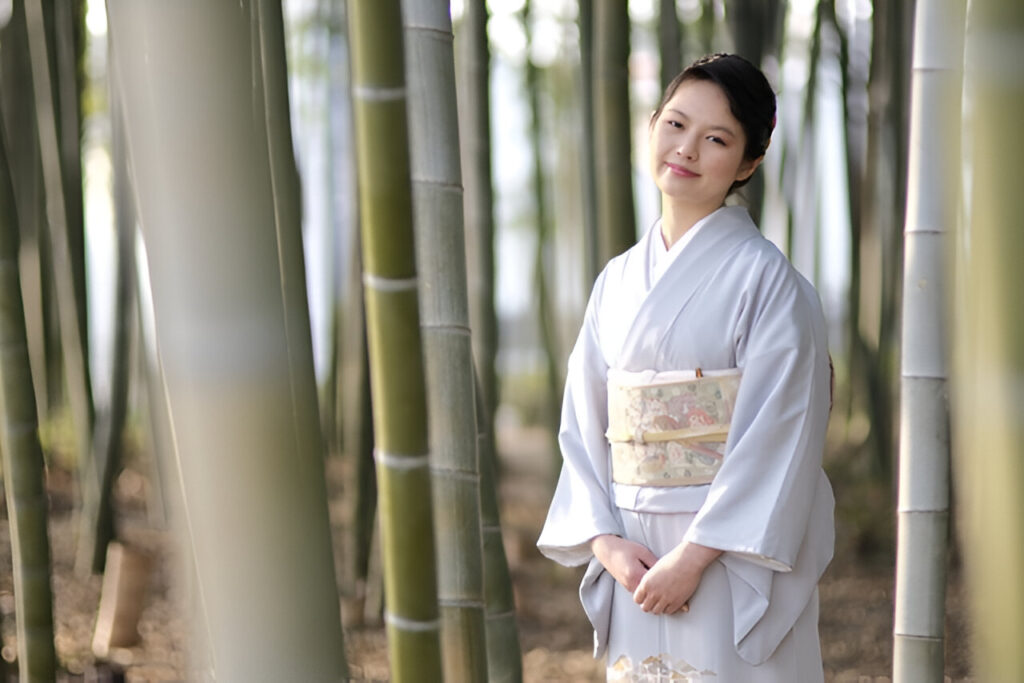
Now, the Iro Tomesode (colorful Tomesode) is where things get a bit more colorful – literally! Unlike its black counterpart, the Iro Tomesode can be any color but black. It’s also worn by both unmarried and married women, making it more like the causal dress of the kimono world.
The fabrics here can range from unpatterned silk to ornately designed textiles, bringing a splash of personality to formal events. For the royalty and those attending the Imperial Court, black’s a no-go since it’s considered a color of mourning, so Iro Tomesode is the go-to option.
Besides, although the Iro Tomesode features the same upper simplicity as the Black Tomesode, its patterns have their own meanings:
- Five Family Crests + Double Wing Tailoring: Same rank as Black Tomesode, fitting for weddings, honorees, and other formal events.
- Three or One Family Crest: The rank is equivalent to a Homongi, ideal for family weddings, congratulatory parties, or graduation.
Homongi 訪問着(ほうもんぎ)
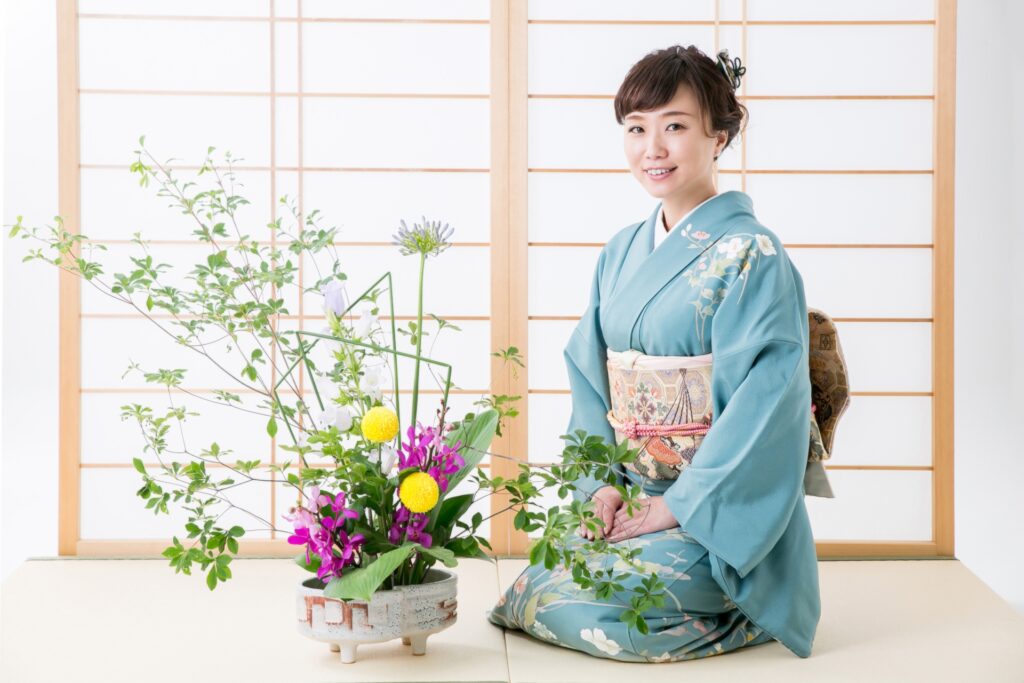
The Homongi ranks after the Black and Iro Tomesodes in formality, suitable for both married and single women. It is appropriate for attending weddings (excluding close family), tea ceremonies, formal parties, and various celebratory events.
The signature feature of Homongi is its pattern, where motifs extend across seams, connecting areas such as the collar, chest, shoulders, sleeves, and hem. This integrated and intricate design involves careful sketching, disassembling for dyeing, and reassembling, a process that showcases unparalleled craftsmanship.
Historically, there should be three family crests on a Homongi, but this practice has declined. Today, emphasis is placed more on the intricate design itself.
Tsukesage 付け下げ(つけさげ)
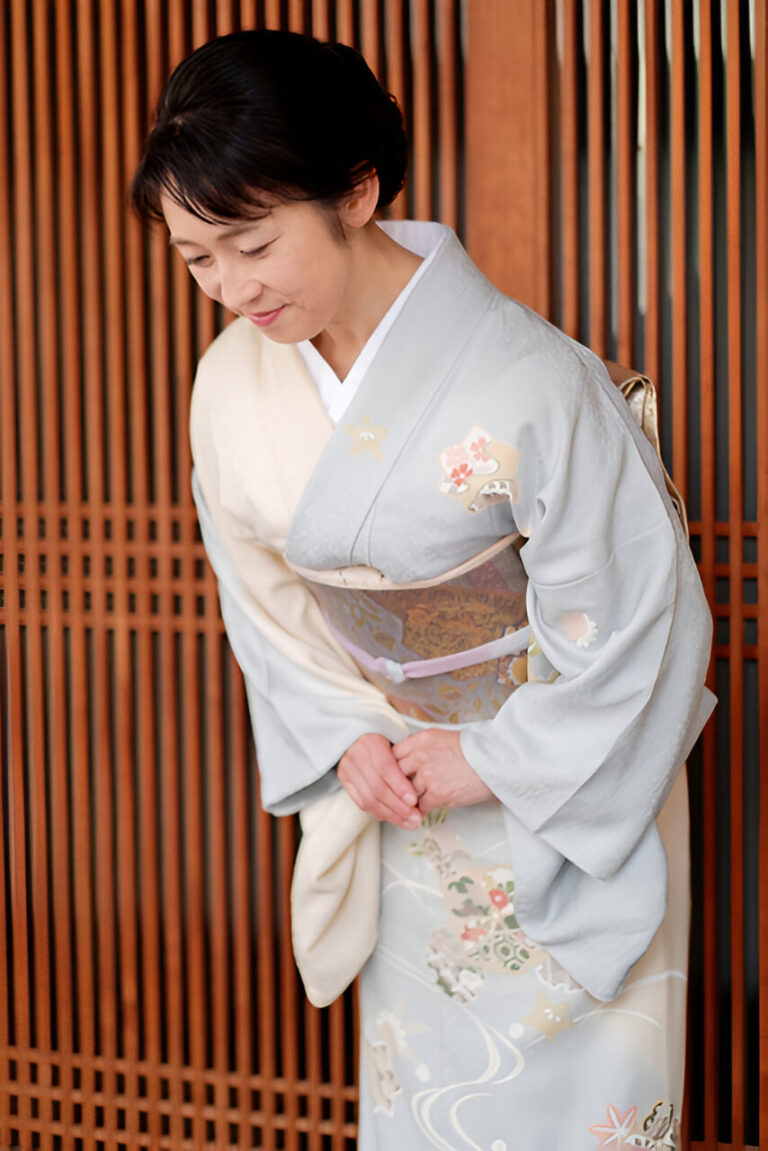
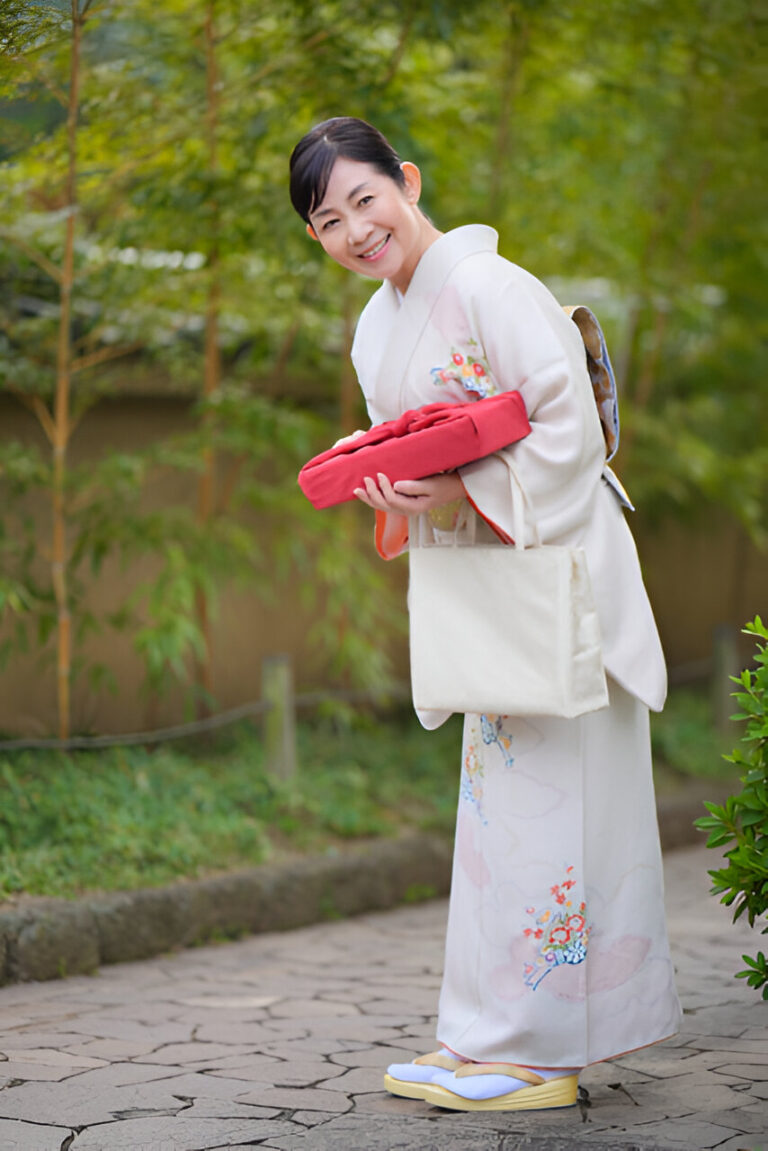
The Tsukesage is a refined, understated type of kimono positioned right behind the Homongi. It is less formal than Homongi but also can be considered semi-formal clothing. You can see it as a well-tailored business casual outfit, suitable for many occasions without being too flashy.
The distinct feature of Tsukesage is its patterns. The patterns, usually representing nature, flow downward from the shoulder, growing in size or quantity as they descend. Unlike the connected patterns of the Houmongi, Tsukesage patterns don’t link across different parts of the fabric. They are usually scattered, like snowflakes in the sky.
You can wear a Tsukesage without a belt or family crests casually for shopping or daily parties. However, a Tsukesage with a formal obi and family crests will be considered a formal garment for ceremonies.
Iromuji 色無地(いろむじ)
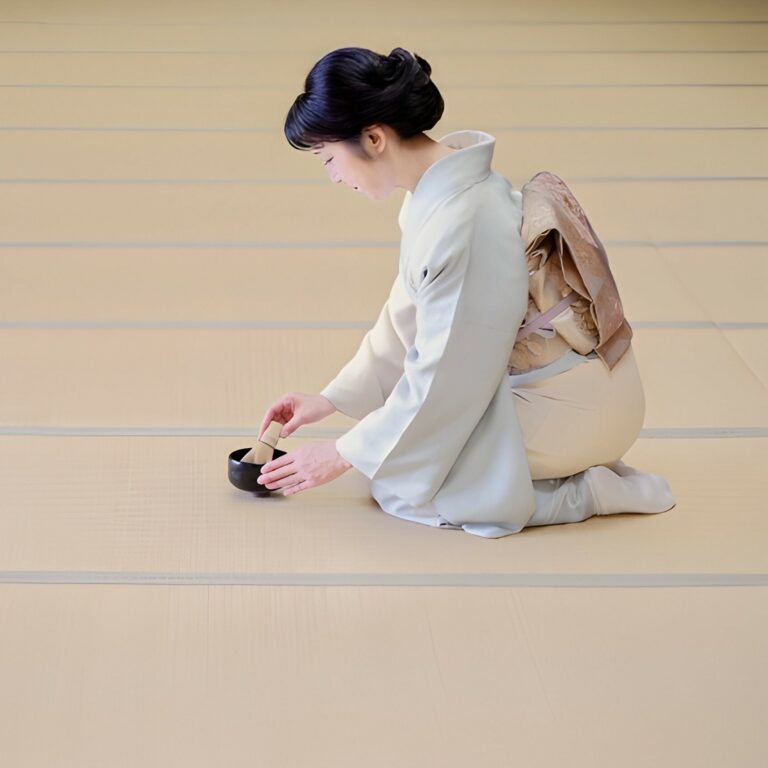
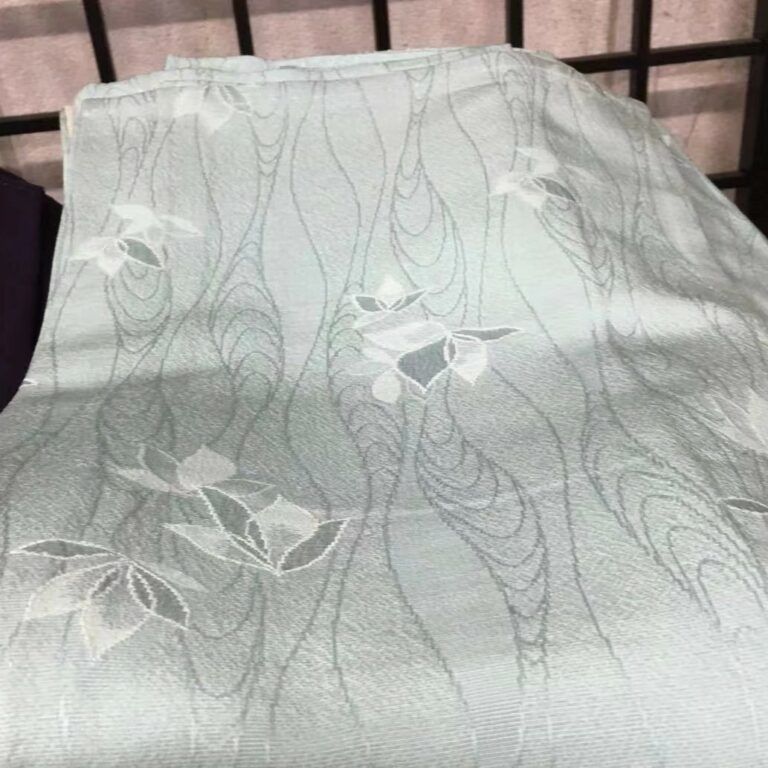
The Iromuji is a masterstroke in the world of Japanese kimonos. It is suitable for both women and men. At first glance, it might seem like a basic garment with no patterns, but it’s the details that make this piece stand out. Its underlying fabric texture, known as ‘地紋’ (Jimon), gives it a distinct character and the choice of color lends it a particular grace.
Depending on how you dress it up or down, the Iromuji can fit any scene. Throw in some family crests, and you’ve got an outfit suitable for grand ceremonies. Skip the crest, and you’ve got an elegant but laid-back look perfect for parties or theater outings.
In tea ceremonies, where subtlety is king, the Iromuji is the first go-to outfit. Its unassuming nature ensures it doesn’t overshadow the ceremony’s delicate instruments and aesthetics. Silk crepe or silk satin is the top choice for tea ceremonies, though other fabric choices can lend it a more casual vibe.
Edo Komon 江戸小紋 (えどこもん)
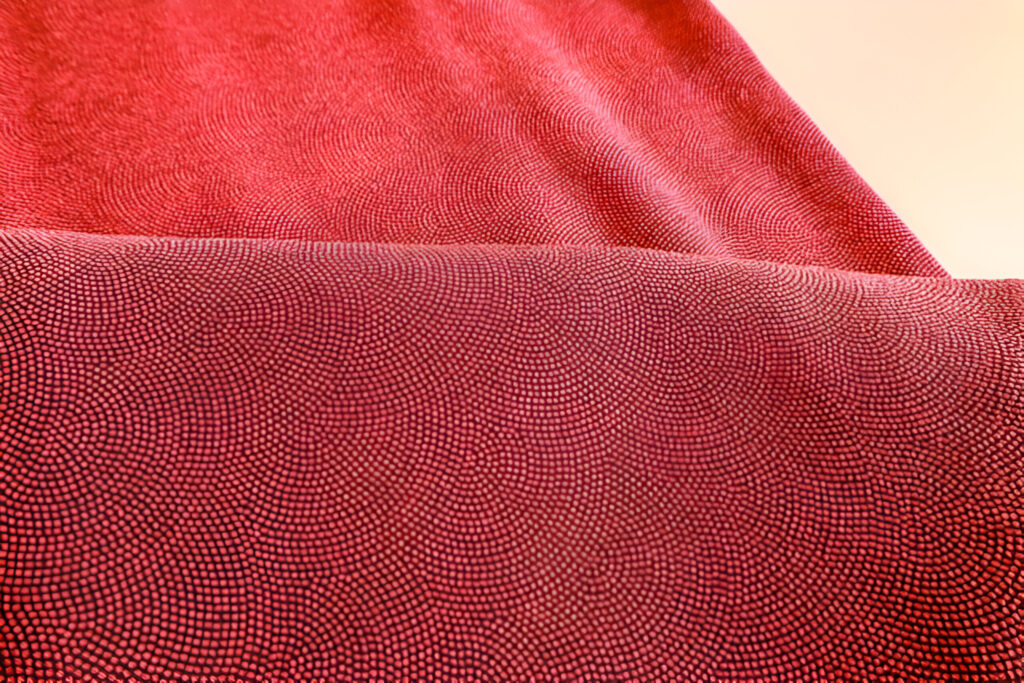
Next, we introduce Edo Komon, a type of kimono that shows almost the same level of formality as Iromuji. Originating from the Edo period, the patterns were first designed for the various daimyo, leading to competition in pattern lavishness. The Shogunate imposed regulations, thus resulting in intricate patterns that appear solid from a distance, showcasing advanced dyeing techniques.
A remarkable aspect of Edo Komon is its use of stencils for dyeing. Today, the scarcity of skilled stencil craftsmen poses a challenge for this art form. Edo Komon is considered high-ranking with small and delicate patterns, so it is suitable for tea ceremonies, graduation, and wedding guests.
Most Komons are casual clothing, but Edo Komon can be seen as semi-formal visiting wear.
Casual Types of Kimono
Komon 小紋(こもん)
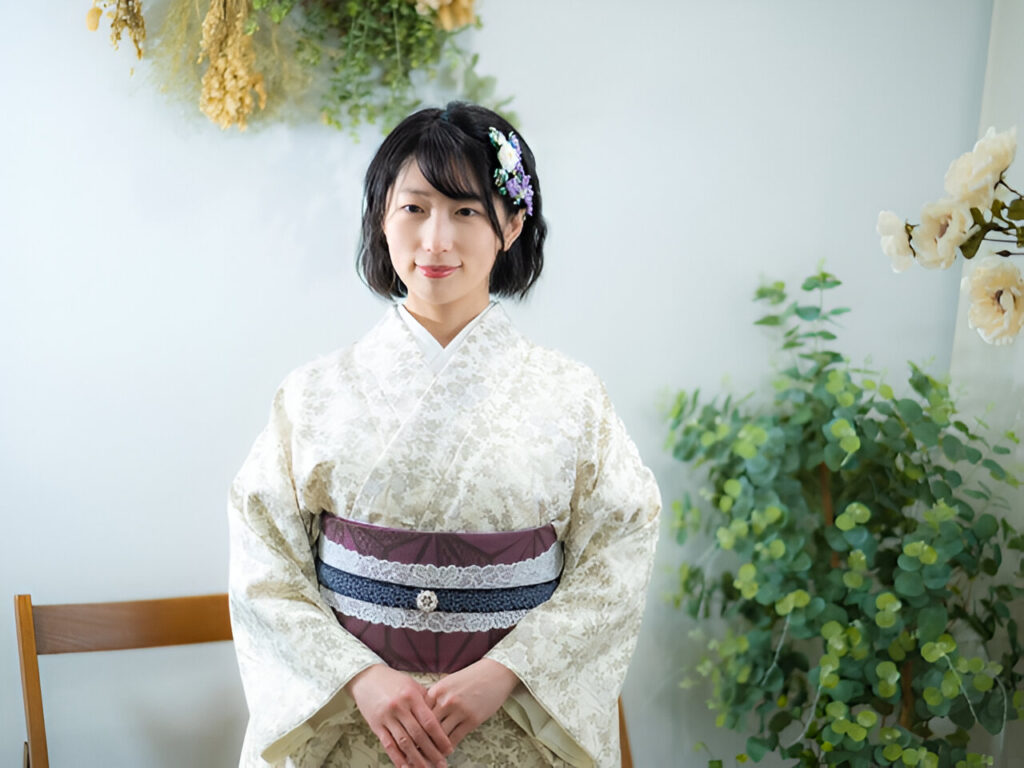
The Edo Komon we introduced before is actually a special kind of Komon. The general Komon is recognized for its detailed, all-over patterns. Unlike Edo Komon, the ordinary Komon is not suitable for formal occasions. It is often associated with daily wear and can include motifs inspired by everyday objects or playful themes.
Besides Edo Komon, Komon has other variations of patterns like ‘Red-Type Komon,’ ‘Tie-Dye Komon,’ and ‘Sarasa Komon.’ They are all for casual occasions and can be elevated to semi-formal wear by a formal obi (belt).
Tsumugi 紬(つむぎ)
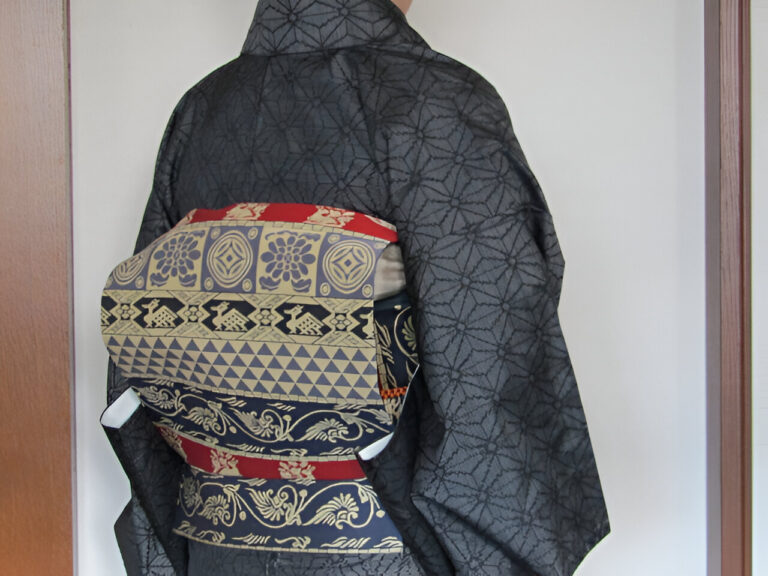
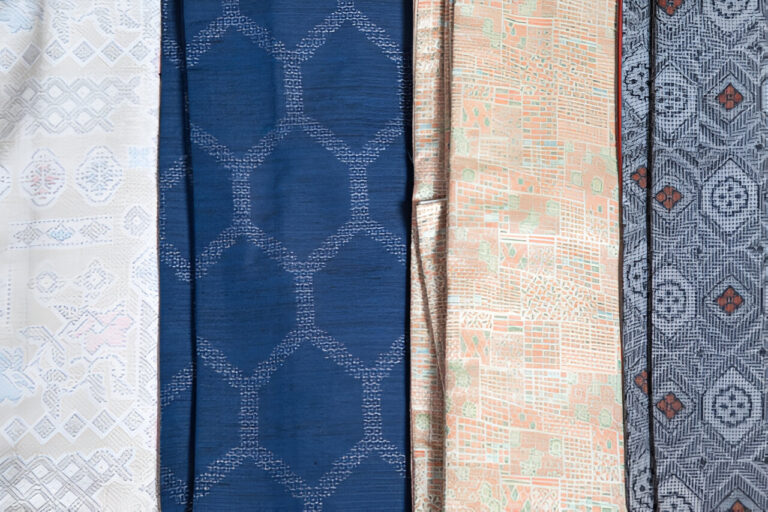
Tsumugi is a type of kimono woven mainly from tsumugi (it is also a fabric name). Tsumugi, a renowned type of silk fabric in Japan, is woven with spun silk threads made primarily from cocoon remnants unfit for conventional silk production. Unlike standard silk, Tsumugi threads are hand-spun, leading to an uneven thickness and multiple knots. This process gives Tsumugi its unique textures, dull luster, and small knobs on its surface, contrasting with the bright sheen of regular silk. Some threads are even spun from cotton, adding further variety.
Historically, during the Edo period, Tsumugi was primarily a commoner’s garment, as clothing regulations permitted only the upper classes to wear pure silk. Tsumugi was created from unusable cocoons by farmers, a practical way to utilize materials that would otherwise go to waste.
In contemporary times, appreciation for the deep traditional craftsmanship involved in Tsumugi’s production has led to its high value. It’s even used to design higher-ranking kimonos, like Homongi. However, it still maintains an informal status and should be matched with appropriate accessories.
Yukata 浴衣(ゆかた)
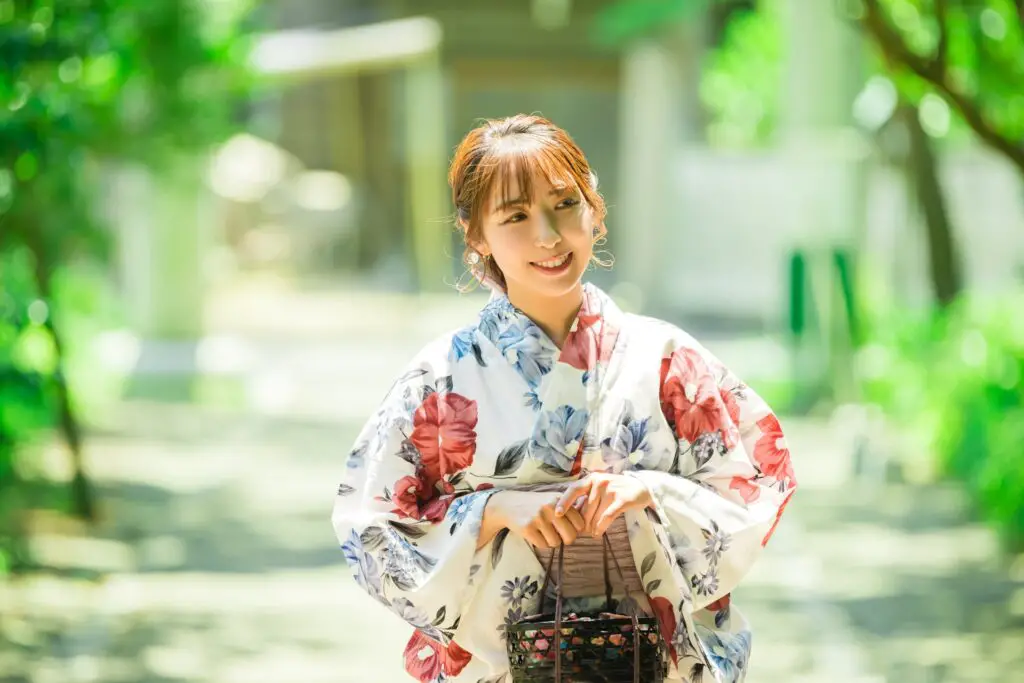
Finally, we come to our old friend, Yukata. As we introduced in the article ‘Yukata vs. Kimono,’ Yukata is considered to be the most informal and the easiest to wear among all types of kimonos.
Characterized by its lightweight fabric, such as cotton and linen, it provides excellent breathability and quick-drying capabilities. Therefore, Yukata is very suitable for summer wear, often seen at festival parties and firework displays.
One of Yukata’s unique features is its lack of undergarments or ‘Nagajuban.’ Unlike other kimonos, it is worn directly against the skin. This simplicity enhances its comfort, allowing for greater freedom of movement. The accompanying belt, typically a half-width obi, reflects the Yukata’s casual status, and wooden clogs called ‘Geta’ are paired instead of the more formal ‘Zori’ sandals.
Final Words
In exploring the world of kimonos, we have witnessed the rich tapestry of Japanese culture. Each kimono tells a story, reflecting centuries of craftsmanship, cultural shifts, and personal expressions. Whether worn on special or everyday occasions, those kimonos symbolize Japan’s vibrant heritage.
If you want to learn more about Japanese fashion, welcome to our Japanese Fashion channel. Feel free to leave a comment if you have any questions or ideas~ We are always here to exchange brilliant thoughts!



